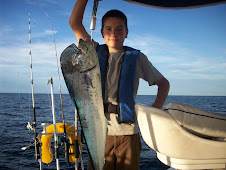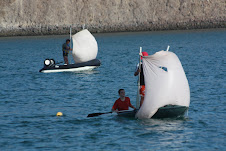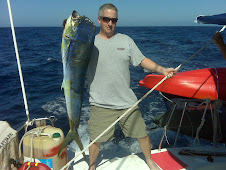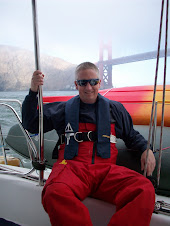 Above is an aerial photo of the village called Mexcaltitlan. It's located on a tiny island in the middle of the mangrove wetlands of the Nayarit coast. A couple days ago, Lori and the kids of 3rd Day joined Patrick, Jack and me on an excursion to visit it. The round trip excursion involved a second-class bus trip, two fairly long taxi drives in tiny sedans crammed with seven people (us and the driver), a ride on a collectivo (small van), and pangas to and from the island. It was quite a journey, and though it didn't go as planned, it was one of those adventures that you can't think about without bursting into laughter.
Above is an aerial photo of the village called Mexcaltitlan. It's located on a tiny island in the middle of the mangrove wetlands of the Nayarit coast. A couple days ago, Lori and the kids of 3rd Day joined Patrick, Jack and me on an excursion to visit it. The round trip excursion involved a second-class bus trip, two fairly long taxi drives in tiny sedans crammed with seven people (us and the driver), a ride on a collectivo (small van), and pangas to and from the island. It was quite a journey, and though it didn't go as planned, it was one of those adventures that you can't think about without bursting into laughter. Mexcaltitlan was worth the effot. This island town is believed to be the ancient homeland of the Aztecs. When the conquistador Cortez met with the Aztec Emporer Montezuma in Tenochtitlan (now Mexico City), Montezuma told Cortez that all the Aztecs were immigrants from a land called Aztlan (the place of the herons). The Aztecs had long ago forgotten where that was. All they knew was that Aztlan was a magical island with seven caves. Since then, the archeologists have pegged this town as the place they came from.

By the time we had navigated all the transportation hurdles, and had finally set foot on the island, we found that we had little time for much more than a lunch and a quick look round before we had to leave to catch the last collectivo home. The town was very attractive with narrow cobbled streets (no cars obviously), red tiled roof homes, and a lovely town square. Standing in the town center, looking down the main avenue in both directions, you could see the shores on either side. It is quite a tiny town with about 2000 inhabitants. Of course the museum of the Aztecs that I so wanted to see was closed despite the fact that the sign said it should be opened! Knowing Patrick, he probably called ahead and promised them money if they would close early - he hates museums.
Our lunch was quite the experience. It was one of the strangest meals we've eaten in Mexico. Only shrimp and fish were sold as you can imagine on an island in t he middle of nowhere. The most unusual thing was the plate of deep fried, whole shrimp. I usually avoid eating things that still have their eyes on them, but they were pretty good.
he middle of nowhere. The most unusual thing was the plate of deep fried, whole shrimp. I usually avoid eating things that still have their eyes on them, but they were pretty good.
As you would imagine, the town survives on fishing and tourism. We saw many vacationing Mexican families who had traveled out to Mexcaltitlan, but we were the only non-native tourists I saw.
Our lunch was quite the experience. It was one of the strangest meals we've eaten in Mexico. Only shrimp and fish were sold as you can imagine on an island in t
 he middle of nowhere. The most unusual thing was the plate of deep fried, whole shrimp. I usually avoid eating things that still have their eyes on them, but they were pretty good.
he middle of nowhere. The most unusual thing was the plate of deep fried, whole shrimp. I usually avoid eating things that still have their eyes on them, but they were pretty good. As you would imagine, the town survives on fishing and tourism. We saw many vacationing Mexican families who had traveled out to Mexcaltitlan, but we were the only non-native tourists I saw.

















 Actually it was a lot of fun. The careening went very well. Any day that you can put your boat up on the beach without damaging it is a successful day. And we had Lori and Amy from 3rd Day around to help us have some fun. While we were waiting for the tide to recede enough to get to work, we all played a rousing game of Parcheesi. Then Lori and Amy went off to our favorite taco stand and brought back a hearty lunch we shared on the beach. Good friends are at the heart of the fun of cruising.
Actually it was a lot of fun. The careening went very well. Any day that you can put your boat up on the beach without damaging it is a successful day. And we had Lori and Amy from 3rd Day around to help us have some fun. While we were waiting for the tide to recede enough to get to work, we all played a rousing game of Parcheesi. Then Lori and Amy went off to our favorite taco stand and brought back a hearty lunch we shared on the beach. Good friends are at the heart of the fun of cruising. Cruising is a lot fun, but my God it is not a life for the lazy. There is always another project waiting, and lots of them require a lot of effort. As hard as we worked this day to clean the bottom, it was still a lot easier than it would have been if we had tried to do it while snorkeling around the anchored boat. Our barnacle situation is getting out of control since we got such a crappy bottom paint job in La Paz last year. But that is another blog post soon to be coming to a computer near you..
Cruising is a lot fun, but my God it is not a life for the lazy. There is always another project waiting, and lots of them require a lot of effort. As hard as we worked this day to clean the bottom, it was still a lot easier than it would have been if we had tried to do it while snorkeling around the anchored boat. Our barnacle situation is getting out of control since we got such a crappy bottom paint job in La Paz last year. But that is another blog post soon to be coming to a computer near you..
















